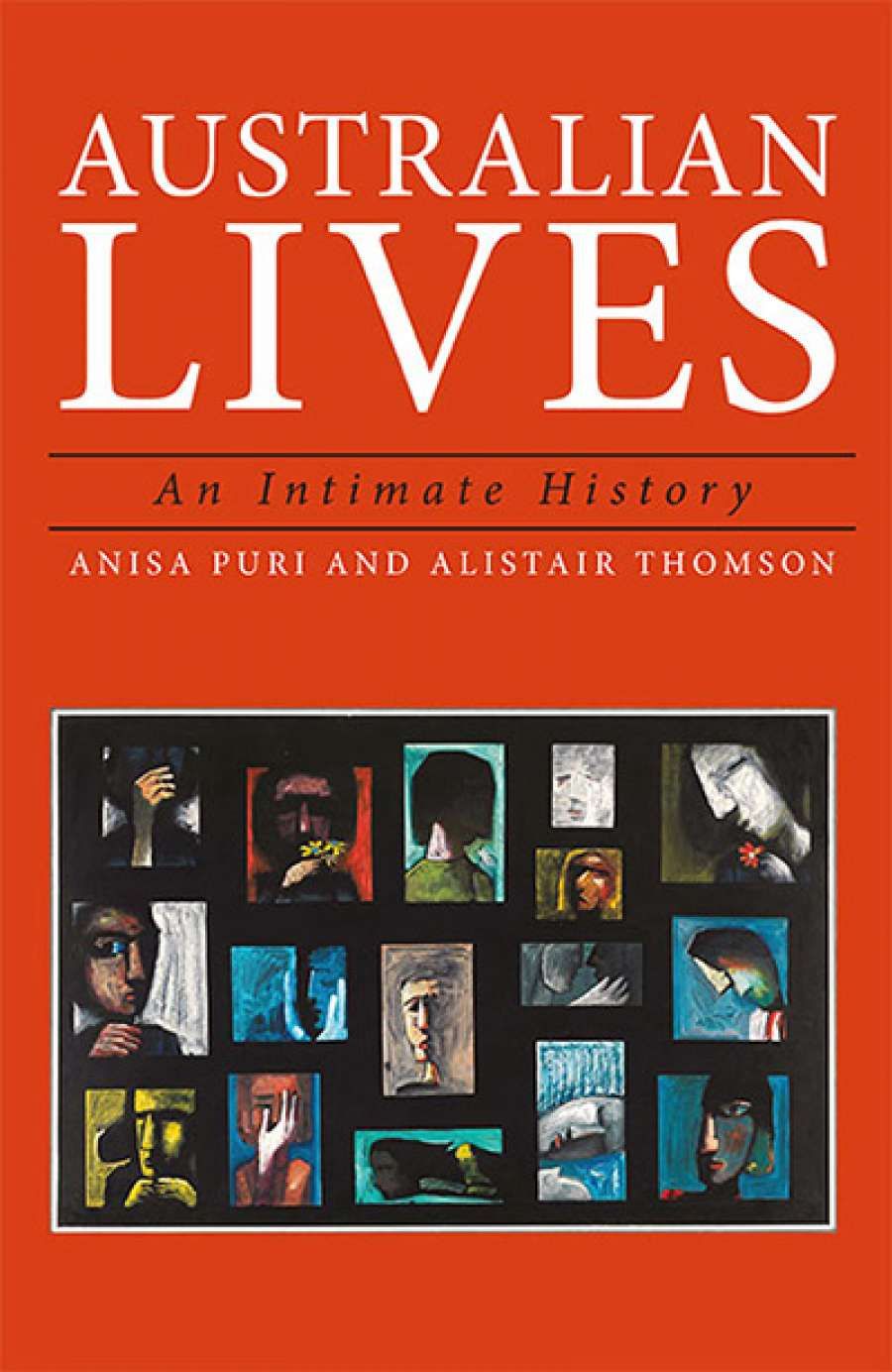
- Free Article: No
- Contents Category: Australian History
- Custom Article Title: Agnes Nieuwenhuizen reviews 'Australian Lives: An intimate history' by Anisa Puri and Alistair Thomson
- Custom Highlight Text:
Meet Ruth Apps, born 1926 and gleefully proud of her Irish convict ancestry. Her father lost the use of an arm in Gallipoli and was also mentally affected. During World War II he slept in the yard to avoid bombs. Ruth won a scholarship to a selective girls’ high school in Sydney when few girls were educated beyond primary school ...
- Book 1 Title: Australian Lives
- Book 1 Subtitle: An intimate history
- Book 1 Biblio: Monash University Publishing, $39.95 pb, 440 pp, 9781922235787
Ruth Apps’s story is one example of the quotidian lives and wider experiences finely documented in Australian Lives. This is an impressive overview in terms of ‘age [people born from the 1920s to the 1980s], social class and educational background, gender, sexuality, disability, region ... regional and remote Australia, indigeneity and ethnicity’. The forty-nine other interviewees in Australian Lives were selected from 300 participants chosen from some 700 volunteers for the ‘Australian Generations Oral History Project, a collaboration between historians at Monash and La Trobe universities, the National Library of Australia, and ABC Radio National’. The intention was to produce an ‘intimate history’. In their introduction the authors, Anisa Puri and Alistair Thomson, explain:
Intimate histories illuminate everyday life as it changes across time. Big picture histories often focus on pivotal events of politics, war or industry that are well-chronicled and widely reported. The lives of so-called ‘ordinary people’, and how they are affected by social, economic and political forces, are less well-documented and require novel historical sources.
How readers respond to the lives and voices presented will depend partly on their own ages, interests, and experiences. Despite my being more than ten years younger than Apps, many of her views and anecdotes were immediately and amusingly familiar. Younger readers may be amazed or bemused by the mores and restrictions of her times. Apps first went to a Catholic school where the nuns insisted: ‘You don’t walk on the same side of the street as Protestants.’ Like other teenage girls of her time, she began assembling a Glory Box. How many younger women today would even know what that is?
For a non-academic reader, negotiating this book could be a puzzle. The organising principle is logical but complex. There are chapters on: Ancestry, Childhood, Faith, Youth, Migrants, Midlife, Activism, Later Life, and a final section titled Telling My Story, detailing the participants’ motivations and impressions of the process. The book is a treat if only for this illuminating and moving section. Chapters have sub-sections. One set of chapters ‘traverses the life-course’ and these are interspersed with ‘thematic chapters’: Each chapter is introduced by a synthesis of what is to come. This can be repetitive, confusing, and occasionally just too much. To gain a comprehensive overview of Apps’s life – and that of others – I chose to read every entry on these ‘across’ the book; quite a painstaking process and perhaps more like reading a memoir than a historical snapshot of times and themes.
 Bill and Ruth Apps, 1947
Bill and Ruth Apps, 1947
(photograph courtesy of Julie Apps)The interviews are available to listen to online, and there are extensive notes and links to further reading. Participants were interviewed in various parts of Australia for four hours over two days. There was no television in Ouranita Karadimas’s (born in 1958) home in Albury, but she used to read a lot and remembers loving Gone with the Wind and collecting Enid Blyton books. David Cooper (1959) recalls struggling to read and now thinks he was dyslexic and that this stopped him joining the police force. ‘I remember being yelled at a lot, and ... being frustrated and I didn’t like school because of that.’ Whilst some, like Ouranita, talk about their reading, especially in childhood, and of enjoying specific sports and fishing, bike-riding, drawing, music, and later video games and smart phones, there are no discrete sections on the arts, literature, or even sport and how these might have shaped lives. This seems a significant omission. There is a short section titled ‘Fun!’ where some of these interests are noted. Ben Peek (1976) is devoted to playing online games with people around the world. He thinks: ‘It’s the most amazingly geeky pastime whatsoever but it’s cost effective, and fun.’
Changing attitudes and policies to Indigenous Australians and immigrants are well canvassed. We meet Australians whose origins were in South Sudan, Poland, Germany, Holland, China, England, Ireland, Bosnia, Malta, Greece, and the former Yugoslavia. Surprisingly, there are no volunteers from Southeast Asia. Many of the issues covered have contemporary resonances and iterations: housing, family conflict, domestic violence, homosexuality; shifting attitudes to race, colour, faith, marriage, work, retirement, ageing, death, and living with disability. The extracts have been carefully curated but not over-edited, thus capturing and conveying character and voice. The language is colloquial, making the interviews feel natural and authentic. Rhonda King (1965) tells her interviewer: ‘You’ve just asked the questions and let the answers come out however they do come out.’ We become privy to so many rich and varied lives and stories.


Comments powered by CComment